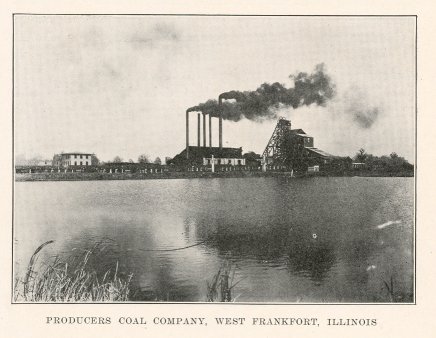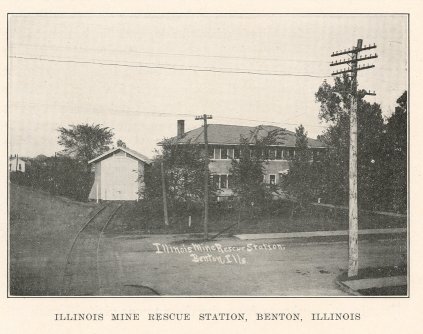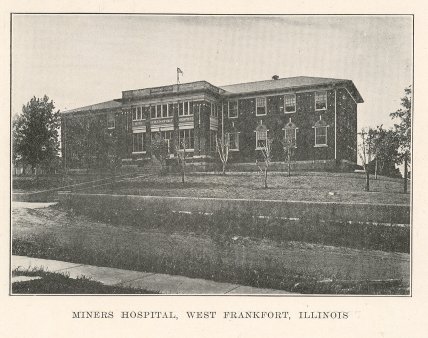
Pg 102
Later, in 1824, at a camp meeting near Mcbeansboro, my grandfather and grandmother were converted and soon after Liberty Methodist Episcopal Church was organized by the Rev. Jesse Walker. One authority gives the names of Henry Yost and wife, Sion Mitchell and wife, Alexander McCreery and wife, and John Waller and wife as charter members. The Rev. Benjamin Hancock, a soldier of the Revolutionary War, whose grave we sometimes decorate on the Ing farm, was perhaps a charter member of Liberty Church also. He is also given the credit of organizing the Mt. Etna Church.
Sion Mitchell, a charter member of Liberty Church, and the first school teacher in the county, came from Wilson County, Tennessee, in 1820, locating where Geo. H. Mitchell now resides. He was a public spirited man of ability, was very religious and was devoted to the church. He raised a family that for half a century contributed largely to the strength of this church and to the upbuilding of the community.
On Dec. 20, 1829, at nine years of age, Stanford Ing arrived in this community, and with his father's family, drove up to my grandfather's in the midst of a snowstorm and was given the privilege of stopping in the old log church.
The storm continued, and the church, which stood where Uncle Stanford's grave now is, sheltered them all winter. Nine years later at the age of eighteen years, Stanford was converted at Fancy Farm, joining the church November, 1838. In 1850 he was licensed to preach at the Liberty Church. He removed to Missouri in 1857, where he was actively engaged in the ministry until the war broke out. In 1861, he raised the first band of soldiers in that part of the state, and going with them, served in the Federal Army until 1863, when he returned to his chosen work. From 1868 to 1870, he had the distinction of serving as chaplain of the Missouri Legislature, later he was presiding elder of the Rolla District. His was an exciting and heroic life in Missouri in war times. Because of his pronounced loyalty to the Union he was often threat-
Pg 103
ened and mobs even made attempts upon his life. But the Lord, "Whose he was and whom he served," brought him through dangers and after many busy, useful years, gave him the desire of his heart, to come back in his old age to the home of his childhood to rest a little while and to lay his wearied body down in this spot held so sacred by him.
I very well remember the Rev. Braxton Parrish, perhaps the most noted of the pioneer preachers, and settlers of this community, and for whom the town of Parrish was named. He went home from church with us one Sunday for dinner when I was a small boy, and scandalized himself in my eyes, by firing a toy gun that I was showing him. I had been better trained than to shoot a gun on Sunday.
Along with these already mentioned were Zadoc Mitchell, who died on the night the stars fell, Robt. Watson, John Keely, Joshua Barrett, Bowen Webb, Wm. Boyd, Cornelius Swain and Anthony Waite, who with their families, were pioneer settlers and pioneer settlers of the church, whose names are familiar to some of us who never saw their faces. Other early settlers were the Clarks, Crawfords, Newmans, Hursts, Laymans, and the Plasters.
Among the early preachers, local and traveling, were David and Henry Yost, Elkins, Launius, Prentiss, Files, Parrish, McMustry, Crawford, Lock, Shepherd, Cullom, Nail, Sears, Casey, Kimber, Carter, Allen, Lopas, Johnson, Earp, Lowe, Hill, Spencer, Bruner, Rutledge, Vancleive, Thatcher, Lakey, Knapp, Holt and Laughlin. The first building erected in 1826, stood just north of the one that succeeded it, and was used for both school and church purposes. After it was destroyed by fire, a second log house was built where Uncle Stanford, at his request, was buried. I remember this building very well, for two reasons: there I attended the first Christmas tree of which I have any recollection, and there I spent my first day in school.
The incomplete list of preachers above, brings us down to the time of the erection of this building. The contract was
Pg 104
let to J. G. Mitchell. The building was dedicated June 26, 1864, during the pastorate of Rev. R. W. Laughlin and by the presiding elder, Rev. J. H. Hill. The writer of this sketch made his first public appearance on that occasion, being two months old.
This in brief is the early history of our church and community, very imperfect, I feel, but giving you a glimpse of the beginning of things in our midst.
I find one item of much interest to me. In one of the histories it is told that the legislature in 1841, authorized the establishment of a college within two miles of the residence of Alexander McCreery, which was to be known as "Fancy Farm College" with Alexander McCreery, Henry Yost, Sion Mitchell, Richard Cantrell, Wm. Jones, Wm. Mitchell and John Roberts as trustees. But it seems that the college failed to materialize.
Fancy Farm in 1852 or 1853, came into the possession of Geo. R. Marvel from Indiana, who distinguished himself during the Civil War, becoming colonel of the 13th Ill. Cavalry.
The forefathers early provided good school advantages and the community was widely known as an educational center.
Only lack of time and the fear of tiring you with the length of this paper, prevents me from bringing in those characters of the second generation and those families that located in the fifties and sixties, and who were bearing the burdens of the church and were active in the community life when the writer was but a boy.
The Tates-Uncle George and Uncle Charley; the Shepherds-Uncle Hamilton and Uncle Ashur; Joseph Biggs, Dr. J. F. McAually, the Marvels, W. A. Stewart, Cyrus McCreery, the Mitchells-J. G. Zadoz and Charley; the Kays-Louis and George; the Poindexters, Mr. Delaney, Samuel Gardum and others that might be mentioned; local preachers, exhorters,
Pg 105
class leaders, Sunday School teachers, superintendents, stewards, trustees, members, efficient, faithful, loyal, are held in sacred memory.
I suppose that Aunt Lavina Newman has the distinction of having longest been a member of Liberty Church of any one now living, having been a member for 65 years or more.
She is now 83 years of age.
My mother, Mrs. S. A. McCreery, perhaps holds the second place. She is 82 years of age, and has been a member of the church for 62 years.
What more shall we say; we are indeed "Reaping where we have not sown, gathering up where we have not strewn, are drinking from wells that we digged not." Ours is a blessed heritage.
For over ninety years the gospel of righteousness and true holiness has been preached and exemplified on this sacred spot.
The writer of this sketch had a respect and reverence for the patriarchs, the fathers and mothers in the church, that was akin to awe, and after forty years of membership in Liberty Church, and fellowship and associations with her members, can say that in the main he has had the utmost confidence in their sincerity, their pure motives, their religion. Let us be true to our trust. We have our twentieth century problems.
May we be the "worthy sons of noble sires" and in that last great day, the day of reckoning, may Liberty Church be presented to the Master, "a glorious church; not having a spot or wrinkle or any such thing, but that it should be holy and without blemish." Amen and Amen.
(Read at the Centennial Celebration at . Liberty M. E. Church, August 10, 1918.)
The town of Thompsonville is located on the I. C. R. R. near the center of the township and has a population of about 800. The town was founded by Richard Thompson when the railroad was built in 1878. "Dick" Thompson, as he was
Pg 106
familiarly called, bought tobacco at this point for a long while. Bowman Bros. was a leading firm that did considerable business in Thompsonville. Perhaps the oldest business in Thompsonville now is the drug store of J. J. Bundy. The store of Burns & Co. is one of the largest department stores in Southern Illinois. The lumber yard is managed by Wm. McCreery, a scion of the original McCreery stock.
Thompsonville has a bank and an excellent bank building and can boast of a very fine school and school building.
Parrish is another station on the I. C. R. R. that has an important history. It was a trade center for wheat buying, and it is said bought more wheat then than any point in the county in its day. Jones Bros. established the first dry goods store in Parrish and did a big business, then going to Benton, they continued to do a large business; from Benton to Kansas and continued to enlarge their business and finally reached Kansas City, where they established a large wholesale business. So a small town sometimes trains men to carry on a large business in the great cities. Parrish took its name from the country postoffice that was located north of Parrish. The postoffice was named in honor of the Parrish family, of whom Braxton Parrish was the progenitor.
The schools of Cave Township are: Pleasant Hill, Autin, Parrish, Reed, Thompsonville, Saul, Liberty, Mt. Zion and McReynold.
The churches are: Baptist-Thompsonville, Pleasant Hill, Parrish; Methodist-Thompsonville, Parrish and Liberty.
Politically Cave Township is Republican.
There was a trading point and rendezvous for drinking men, generally known as "Sneak out," about a mile north of Parrish on the Old Shawneetown road. This point dispensed with booze in any way they wanted to buy it. There is nothing to mark the famous booze joint resort. It only lives in the memory of some of our older citizens.
Pg 107
Frankfort Township lies west of Cave and south of Benton. It took the name of the county seat that was located within its confines.
There were two causes that contributed to Frankfort's dense population in the early history of the county. First, the opening up of the Kaskaskia-Shawneetown road through Frankfort and second, the location of the county seat on the hill in the township.
The early settlers were Elijah Ewing, Thomas Roberts, John Crawford, Solomon Clark and Moses Garret. These families were in the township at an early date-as early as 1810 or '12. The families coming later were the Ices, Fitts, Rotramels, McClintocks, Martins, Bryants, Walls, Pinkstone, Cars, Estes, Ross, Cunninghams, Rains, Willinows, Nolens, Moores, Bennetts, Melvins, Neals, Newmans, Harrels, Sinks, Dimmicks, Evans, Bonors [Boner's], Colemans, Maddoxs, Hays, Woods, Dorris and others, and from this stock of people have come some of the best people of the county.
The county seat was established in this township, and Frankfort town the oldest in the county, became famous as an inland trading center.
Fitt's Hill and Old Greenville were trading posts for their day, but have long since been forgotten by most of the people of Franklin County.
West Frankfort is a thriving city on the C. & E. I. R. R. The towns of West Frankfort and Old Frankfort now contain a population of 12,000 or more.
The schools of Frankfort Township are: Crawford's Prairie, Neal, Deering City, West Frankfort, Frankfort Heights, Wall Town, Garrett's Prairie, Weaver and Union.
Pg 108
The churches are: Baptist, West Frankfort, Frankfort Heights, Crawford's Prairie, and Pleasant Grove; Methodist-Frankfort, West Frankfort, and Antioch; Christian- West Frankfort; United Brethren-Bonor [Boner]. The township politically is Republican. John Hand is the present supervisor.
In the vicinity of Frankfort, more people had settled about 1812 to 1815 than in any other locality in Franklin County. The Ewings, Roberts, Crawfords, Hubbards, Jordans, Garretts, Dements, Dennings, Estes, Clarks, Neals and Cantrels, had settled in and around Frankfort until it was the most densely populated portion of the county at that early period.
When the county was organized Jan. 2, 1818, there was not a town or village in the entire territory of Franklin Co. The act of the territorial Legislature, creating Franklin County,

Pg 109
made the new county seat at the tavern of Moses Garrett, on the Kaskaskia-Shawneetown road about three miles east of Frankfort Hill. This old county seat was located on the Old Henry Hays farm, near the old homestead of Bennie Bryant. The county seat was at this old log house tavern and in a log house near for eight years.
The act creating the county, also named commissioners to locate the county seat of the new county; but these commissioners failed to locate the county seat. The legislature of the new state of Illinois (Illinois admitted Dec. 3, 1818) February 1, 1821, passed an act appointing Conrad Will of Jackson County, Isaac Casey of Jefferson, Samuel Omelvany of Pope and James Kirkpatrick of Washington as commissioners to locate the new county seat.
These commissioners selected the hill in Sec. 20, of Frankfort Township Town 7 R. 3 E. as the site for the new county seat in 1821. Previous to this a number of people had settled around the hill. The name of Frankfort took its name from Francis Jordan's Fort, about four miles away. The first court house was erected on the hill and was made of logs with puncheon floor made smooth with an adz, and the boards of the roof were fastened on with nails that were hand made. It was occupied in 1826. Later than this a brick court house 20 ft. by 30 ft. was erected which was the first brick structure ever made in the county. This famous old courthouse was used till 1841, when the county seat was moved to Benton.
As the county began to grow and develop so did the first town in Franklin County. Back in the 30's and 40's Frankfort took its place alongside of other flourishing towns of Southern Illinois, such as Brownsville, Kaskaskia, Lusks, Elvira, Bainbridge and Shawneetown. These towns have all passed into oblivion except Shawneetown, and live now only in the memory of our oldest people. Frankfort was considered the most important town in the interior of Southern Illinois, rivaling Shawneetown or Chicago at this early period. Prominent merchants from the river towns visited Frankfort,
Pg 110
also the old time lawyers came to Old Frankfort to hold or attend court.
The early merchants of Frankfort were Dorris and Elstun and Mobley Bros. Solomon Clark was an early dealer in family groceries and liquors. Dorris and Elstun had the distinction of putting up the first store in Franklin County. It was at this store that Braxton Parrish bought his twenty-four yards of domestic and paid for it in other skins, as mentioned in his famous lecture delivered at Benton in 1874. (See elsewhere for lecture.)
Around this historic spot on Frankfort Hill clusters more history of the early days in Franklin County than any other spot.
It was here or near here where the wheels of machinery of our county governmnt were first started. Here, where S. M. Hubbard (the late father of Geo. T. Hubbard) acted as County Clerk, Circuit Clerk, Probate Judge and Master-in-Chancery one man filling all these county offices. Here David

Pg 111
Maxwell was sworn in as the first sheriff of the county. Here began Hon. Wm. A. Denning to practice law, also Judge W. B. Scates, who was the county's first Circuit Judge and later Judge of the Supreme Court. Great lawyers of early days got their first practice in court at Frankfort.
The hey-day of Frankfort was now feared to be over, as, by act of the Legislature of 1839, Franklin County had been divided. The south half was organized into a new county called Williamson and a new county seat was inevitable. This was a great surprise to the people of Frankfort.
The citizens protested but it did not prevent the moving of the county seat. The commission appointed by the legislature selected Benton as the place for the new county seat. Frankfort now seemed doomed, yet the staid old town continued on without the county seat. Much business was done there. A flour mill was erected. It was a great castor bean and tobacco market for years. Some of the best people in the county - the Dimmicks, Horrills, Clarks, Colemans,
